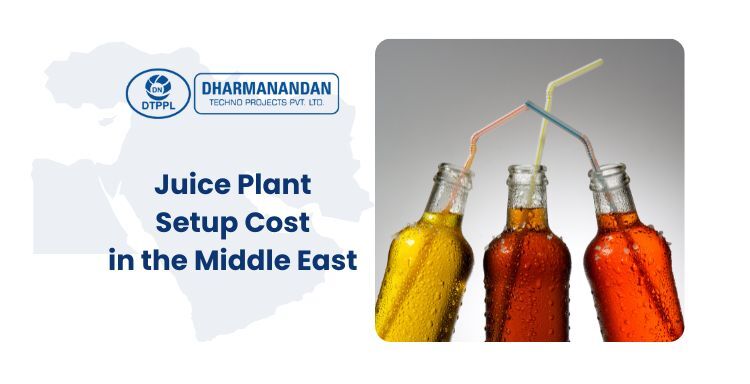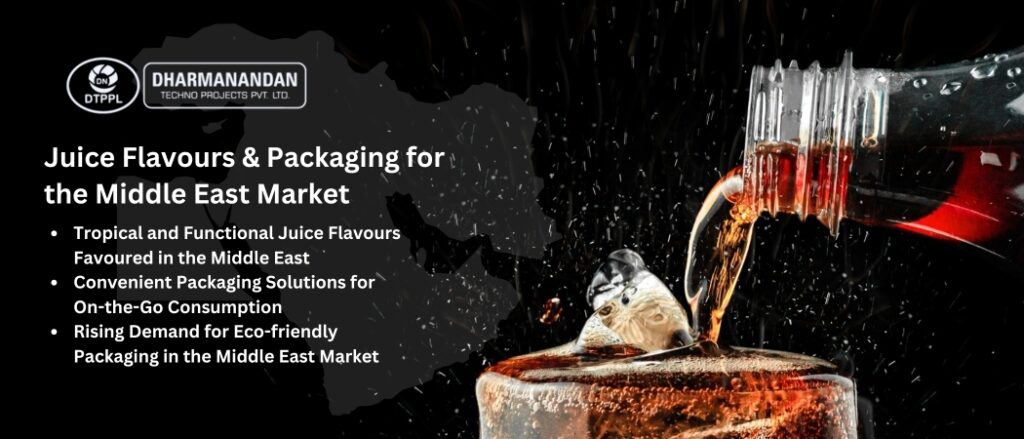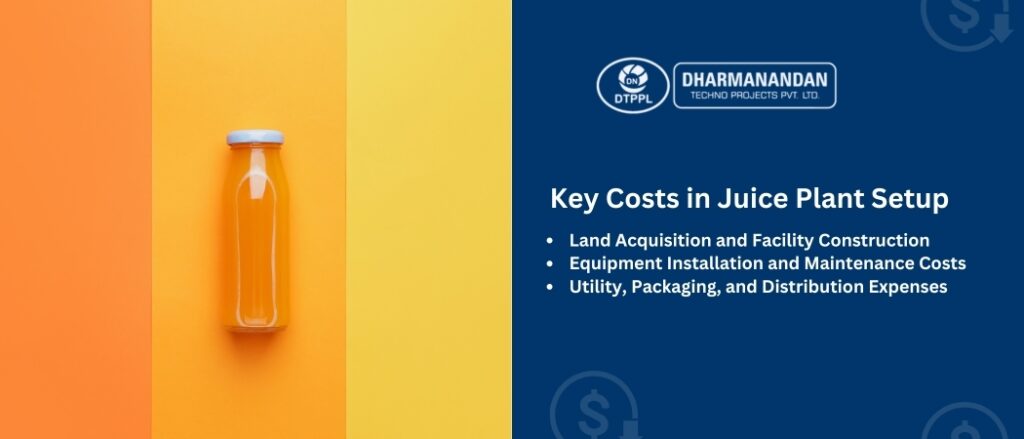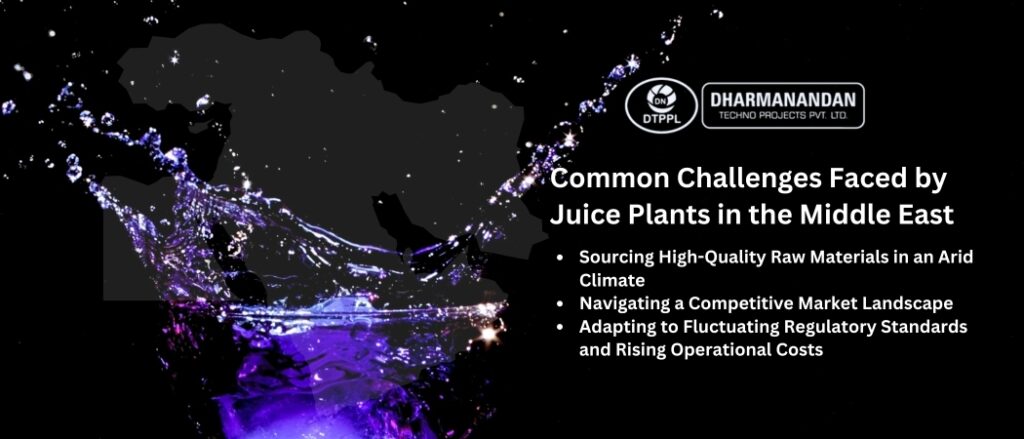
Table of Contents
Juice Plant Setup Cost in the Middle East : A Comprehensive Guide
September 11, 2024
The juice production industry in the Middle East has seen tremendous growth in recent years, driven by the region’s increasing demand for healthier beverage options. As more consumers become health-conscious, the market for fresh and packaged juices has expanded significantly. Juice production plants play a crucial role in meeting this demand, offering both local and international products. The Middle East, with its diverse population and tastes, is an ideal market for juice manufacturers.
Each Middle Eastern country presents unique opportunities and challenges for setting up a juice plant. From infrastructure to regulatory requirements, understanding the landscape of each nation is key to success. This guide provides a comprehensive look at the costs involved in setting up juice plants across key countries in the region.
Understanding Juice Production Plants
A juice production plant is a facility dedicated to processing fruits or vegetables into juice, which can then be packaged for sale. These plants require specialised equipment for extraction, filtration, pasteurisation, and bottling to ensure high-quality products. A critical component of the juice production plant is its ability to meet food safety and regulatory standards. Technology plays a key role in increasing efficiency and ensuring consistency across batches.
The juice production plant industry has evolved to incorporate automated systems, reducing manual labour and increasing production output. Moreover, advancements in machinery have enabled plants to diversify into various juice types such as fresh, concentrate, or mixed varieties. Understanding these technological advancements is essential for setting up a competitive juice plant.
Factors Influencing Juice Plant Setup Cost
Setting up a juice plant involves several key cost factors, with equipment and machinery being the largest investment. From fruit washers to packaging lines, each piece of machinery comes with its own cost considerations. Labour costs also play a significant role, particularly in countries where hiring skilled workers might be a challenge. Additionally, the cost of sourcing raw materials such as fruits and water can greatly vary depending on the location.
Another important consideration is the infrastructure, including utilities such as electricity, water, and transportation. These factors can vary by region and influence the overall setup cost. The cost of complying with food safety regulations and obtaining necessary certifications should also be factored in.
Juice Flavours and Packaging for the Middle East Market
In the Middle East, a diverse range of juice flavours and packaging options are well-received. Popular juice flavours include tropical varieties such as mango, pineapple, and pomegranate, which cater to the region’s taste preferences. Additionally, exotic blends and functional juices that offer health benefits, such as vitamin-enriched or low-sugar options, are gaining traction.
When it comes to packaging, consumer preferences often lean towards convenience. Single-serve bottles and Tetra Paks are widely used, providing ease of consumption and extended shelf life. Eco-friendly packaging solutions are also becoming increasingly popular, aligning with the growing environmental awareness among consumers.

Juice Plant Setup Cost in Saudi Arabia
In Saudi Arabia, establishing a juice plant presents a highly promising opportunity, driven by the country’s increasing demand for healthy beverages. While machinery and equipment costs can vary, many businesses benefit from access to high-quality imports from Europe and Asia. Although skilled labour may come at a premium, the Kingdom’s supportive industrial policies help offset these expenses, creating an advantageous environment for investment.
Saudi Arabia’s regulatory framework, particularly around food safety and hygiene standards, ensures high product quality, contributing to consumer trust. The country’s advanced infrastructure, coupled with excellent transportation networks, facilitates efficient distribution of juice products across the region. Entrepreneurs will find that Saudi Arabia provides a wealth of opportunities, with the potential to overcome any challenges with the right strategy.
Juice Plant Setup Cost in Qatar
Setting up a juice plant in Qatar involves navigating a relatively small but rapidly growing market. Qatar’s cost of infrastructure development is high due to its ongoing focus on modernisation. Juice plant equipment in Qatar is often imported, which adds to the overall setup cost. However, the country’s efficient logistics networks ensure ease of distribution across the region.
Labour availability in Qatar is a mix of local and expatriate workers, but hiring skilled workers may come at a premium. Regulatory requirements are stringent, especially in terms of food safety and environmental regulations. Nevertheless, Qatar’s government offers various incentives for industrial projects, making it an attractive option for investors.
Juice Plant Setup Cost in UAE
The UAE has emerged as a hub for food and beverage manufacturing, making it an ideal location for setting up a juice plant. The cost of equipment and technology in the UAE is generally higher, as many businesses rely on state-of-the-art machinery imported from abroad. Labour costs in the UAE vary depending on whether local or expatriate workers are employed, and there are various visa requirements to consider.
Regulatory compliance is essential in the UAE, where strict food safety laws are in place to protect consumers. The UAE’s market trends are also unique, with a growing demand for organic and health-focused beverages, adding potential for higher profit margins. Despite the higher initial setup costs, the UAE offers a dynamic and growing market for juice products.
How DTPPL Can Assist in Starting a Juice Business
DTPPL is a manufacturer, supplier, and exporter of juice plants, and can provide valuable support in launching a juice business in the Middle East. We offer comprehensive solutions, from designing and setting up state-of-the-art juice production facilities to providing the necessary equipment and technology.
Our expertise extends to helping businesses navigate the local market landscape, including insights into popular juice flavours and suitable packaging options. By leveraging our experience, you can ensure that your juice plant meets regional demands and adheres to regulatory standards. We also offer ongoing support to optimise production processes and enhance operational efficiency.
Key Costs in Juice Plant Setup
Land acquisition is one of the first and most significant expenses when setting up a juice plant, particularly in high-demand locations. After securing the land, the cost of constructing or renting a facility suitable for juice production needs to be considered. Equipment installation and ongoing maintenance can also account for a large portion of the setup budget.
Utility costs, including electricity and water, are ongoing expenses that need to be calculated from the outset. Another crucial cost factor is packaging and distribution, as juice plants rely heavily on reliable supply chains to get products to market. These are all critical elements to include when estimating the total cost of setting up a juice plant.

Juice Production Plant Equipment Overview
The machinery used in juice production is vital for efficient and high-quality output. Juice extraction machines vary depending on the type of juice being produced, and they represent a significant upfront cost. Pasteurisation and sterilisation are necessary processes to ensure the safety of the product, and these systems require sophisticated equipment.
Bottling and packaging are equally important, as they ensure the juice remains fresh while reaching consumers. Refrigeration units are required to store raw materials and finished products. Automation systems can also be employed to increase the plant’s efficiency and reduce manual intervention.
Environmental Considerations for Juice Plants
Environmental sustainability is becoming an increasingly important factor for juice production plants. Waste management systems are essential to handle by-products like fruit peels and seeds. Additionally, juice plants consume significant amounts of water, so recycling and efficient usage systems can help reduce operating costs.
Energy-efficient solutions, such as solar panels or energy-saving machinery, can also be integrated into the plant design to reduce long-term energy costs. Many governments in the Middle East offer incentives for plants that adopt renewable energy technologies. Implementing these practices can also improve a company’s environmental footprint, appealing to eco-conscious consumers.
Financial Planning for Juice Plant Setup
Financial planning is crucial when starting a juice production plant, as it helps in estimating both initial investments and ongoing operational costs. One of the largest expenses is capital for equipment and infrastructure. Understanding operating expenses such as labour, utilities, and maintenance is equally important to ensure profitability.
Additionally, it’s essential to conduct a break-even analysis to estimate how long it will take for the juice plant to become profitable. With thorough financial planning, businesses can secure the necessary capital, budget for future expenses, and create strategies for sustained growth in the competitive juice market.
Funding and Financing Options for Juice Plants
Funding a juice plant setup requires significant financial resources, and companies often explore various financing options. Governments in the Middle East, particularly in countries like Saudi Arabia and the UAE, offer grants and subsidies to encourage industrial growth. These incentives can cover a portion of setup costs, making it easier for businesses to get started. Loans from local and international banks are also a popular option, with many offering competitive interest rates.
Private investments and joint ventures are another avenue that many juice production plants explore. Partnering with established players in the food and beverage industry can reduce the financial burden and provide access to expertise. Crowdfunding and venture capital are less common but could be considered by smaller or niche juice producers aiming to tap into specific market segments.
Choosing the Right Location for a Juice Plant
The location of a juice production plant can significantly impact its overall success. Proximity to raw materials, such as fruits and vegetables, is critical to ensure freshness and reduce transportation costs. Additionally, access to suppliers who provide essential components like bottles and packaging materials is another key consideration. Choosing a location near transportation networks also helps in distributing the products efficiently across domestic and international markets.
Utilities such as electricity and water are essential for running a juice plant, and their availability and cost must be evaluated. Furthermore, regions with supportive industrial policies and lower tax rates can reduce operational costs. A strategically chosen location can offer significant long-term benefits, allowing the business to operate more efficiently.

Juice Production Plant Workforce
A well-trained workforce is essential for the successful operation of a juice production plant. Skilled workers are needed to operate machinery, manage quality control, and oversee the entire production process. Training and development costs should be factored into the initial setup, ensuring that staff are familiar with the technology and standards in the juice production industry. While hiring locally can reduce expenses, certain skills might require outsourcing or external hires.
Deciding between outsourcing specific functions or managing them in-house is another consideration for business owners. For example, tasks such as distribution, packaging, or even marketing could be outsourced to specialists. Balancing these decisions can help companies optimise both cost and efficiency in their juice production plant operations.
Regulatory Compliance in Juice Production
Regulatory compliance is a critical factor for juice production plants, particularly in the Middle East, where food safety standards are stringent. Each country has specific regulations regarding the production, packaging, and labelling of juice products. Failing to adhere to these rules can result in fines, product recalls, or even the closure of the plant. Understanding local food safety laws is essential for maintaining compliance.
Obtaining the necessary permits and certifications before starting production is crucial. These certifications not only allow the plant to operate legally but also help build trust with consumers and retailers. Regular audits and inspections are typically required to ensure ongoing compliance, so maintaining thorough records and practices is key to smooth operations.
Juice Plant Technology and Automation
Advancements in technology have transformed the way juice plants operate, making production faster, more efficient, and less reliant on manual labour. Automated systems for juice extraction, filtration, and packaging can help reduce operational costs and minimise human error. These technologies allow plants to scale up production while maintaining consistency in quality. Investing in automation can also provide long-term savings by reducing the need for large workforces.
Automation doesn’t just improve efficiency; it also allows for real-time monitoring and data collection, helping managers optimise production and reduce waste. Future trends in juice plant automation may include AI-driven systems and robotics, which could further enhance production capabilities. Staying ahead of these technological advancements can give juice producers a competitive edge in the market.
Marketing and Distribution Costs
Building a strong brand presence is essential for juice companies to thrive in the competitive Middle East market. Marketing costs vary depending on the strategy, with both online and offline channels playing a role. Digital marketing, including social media ads and search engine optimisation, can help juice brands reach a broader audience. Offline marketing, such as billboard advertisements or partnerships with retailers, is also important, particularly in a region where physical store presence matters.
Distribution costs must also be carefully considered. Depending on the plant’s location, transportation to retail outlets or wholesalers can vary in cost. Effective logistics planning ensures that juice products are delivered quickly and in optimal condition, helping to build consumer trust. Balancing marketing and distribution costs is key to maximising profitability.
Common Challenges Faced by Juice Plants in the Middle East
Juice plants in the Middle East face unique challenges, starting with sourcing high-quality raw materials. Due to the region’s arid climate, local fruit production can be limited, and companies often rely on imports, which can drive up costs. Additionally, the juice industry is highly competitive, with numerous brands vying for market share, making it challenging for new entrants to differentiate themselves.
Another challenge is dealing with fluctuating regulatory standards, particularly as governments adjust policies to meet international food safety norms. Juice plants must remain agile and adaptable to regulatory changes to avoid disruptions. Lastly, rising operational costs, including utilities and labour, can squeeze profit margins, requiring businesses to continuously optimise their processes.

Future Prospects for the Juice Industry in the Middle East
The future of the juice industry in the Middle East looks promising, with continued growth expected across Saudi Arabia, Qatar, and the UAE. As consumers become more health-conscious, the demand for natural, organic, and fortified juices is set to increase. Emerging markets in the region also present new opportunities for juice producers, with governments promoting healthier lifestyles and food choices through various initiatives.
Innovation in juice production, such as the introduction of new flavours and blends, will continue to attract diverse consumer bases. Additionally, technological advancements, including AI and automation, will help reduce production costs and improve efficiency, making the industry even more competitive. The Middle East remains a fertile ground for growth and expansion in the juice sector.
Conclusion
Setting up a juice plant in the Middle East offers significant opportunities, but it also comes with various challenges. Investors must carefully consider the costs associated with machinery, labour, and regulatory compliance in each country. While Saudi Arabia, Qatar, and the UAE each present unique market dynamics, understanding these factors is crucial for success. The juice industry continues to expand, driven by consumer demand for healthier options and innovative products. Collaborating with a leading Juice Plant Manufacturer and Exporter like DTTPL, With the right financial planning, strategic location, and investment in technology, juice producers can find long-term profitability in this growing market. For those willing to navigate the complexities, the rewards of entering the Middle East juice industry are substantial.
